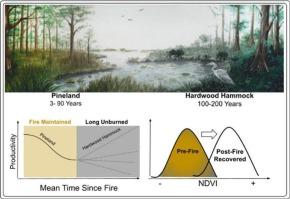火灾提高了佛罗里达大沼泽地适应火灾的亚热带松林的生产力
IF 8
1区 环境科学与生态学
Q1 ENVIRONMENTAL SCIENCES
引用次数: 0
摘要
有些生态系统需要定期干扰以维持其生物和结构多样性。然而,气候变化和土地管理实践的变化改变了全球火灾制度,这使得确定维持依赖火灾的生态系统的最有效方法具有挑战性。测量生态系统对干扰的反应可以为了解火灾在当代条件下的影响提供有价值的见解。在Everglades松林,我们利用卫星数据开发了一个标准化植被指数(NDVI)的机器学习模型,NDVI是初级生产力的有效代表。结果表明:大沼泽地松林NDVI值在0.2 ~ 0.4之间,受火灾历史影响显著;经历更频繁和最近的火灾的地区与那些不太频繁燃烧的地区相比,显示出更高的NDVI值。相反,长时间(15年)未燃烧的松林显示出向不太依赖火的生态系统过渡的迹象。在Everglades松林发生火灾后,NDVI最初减少了约6%。然而,平均而言,在2年内,松林在火灾后恢复到比火灾前更高的NDVI(约27%)。我们的研究结果表明,在亚热带依赖火灾的松林中,更频繁的火灾可以提高生产力,并促进火灾后更快的恢复。本文章由计算机程序翻译,如有差异,请以英文原文为准。

Fires enhanced productivity in fire-adapted subtropical pinelands of the Florida Everglades
Some ecosystems require regular disturbances to maintain their biological and structural diversity. However, shifts in climate and changes in land management practices have altered global fire regimes, making it challenging to determine the most effective approach to maintain fire-dependent ecosystems. Measuring how ecosystems respond to disturbances can offer valuable insights into the effects of fire under contemporary conditions. In Everglades pinelands, we used satellite data to develop a machine learning model for the normalized difference vegetation index (NDVI), an effective proxy for primary productivity. Our findings showed that NDVI values ranged from 0.2 to 0.4 for Everglades pinelands, which were significantly influenced by fire history. Areas that experienced more frequent and more recent fires exhibited higher NDVI values compared to those that were less frequently burned. Conversely, pinelands that had not burned for an extended period (>15 years) showed signs of transitioning to less fire-dependent ecosystems. Following contemporary fires in Everglades pinelands, there was an initial reduction in NDVI of ∼6 %. However, on average, within 2 years, pinelands recovered to a higher post-fire NDVI (∼27 %) compared to their pre-fire levels. Our results suggest that more frequent fires enhance productivity and promote faster post-fire recovery in subtropical fire-dependent pinelands.
求助全文
通过发布文献求助,成功后即可免费获取论文全文。
去求助
来源期刊

Science of the Total Environment
环境科学-环境科学
CiteScore
17.60
自引率
10.20%
发文量
8726
审稿时长
2.4 months
期刊介绍:
The Science of the Total Environment is an international journal dedicated to scientific research on the environment and its interaction with humanity. It covers a wide range of disciplines and seeks to publish innovative, hypothesis-driven, and impactful research that explores the entire environment, including the atmosphere, lithosphere, hydrosphere, biosphere, and anthroposphere.
The journal's updated Aims & Scope emphasizes the importance of interdisciplinary environmental research with broad impact. Priority is given to studies that advance fundamental understanding and explore the interconnectedness of multiple environmental spheres. Field studies are preferred, while laboratory experiments must demonstrate significant methodological advancements or mechanistic insights with direct relevance to the environment.
 求助内容:
求助内容: 应助结果提醒方式:
应助结果提醒方式:


